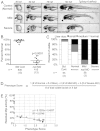A zebrafish model of congenital disorders of glycosylation with phosphomannose isomerase deficiency reveals an early opportunity for corrective mannose supplementation
- PMID: 22899857
- PMCID: PMC3529342
- DOI: 10.1242/dmm.010116
A zebrafish model of congenital disorders of glycosylation with phosphomannose isomerase deficiency reveals an early opportunity for corrective mannose supplementation
Abstract
Individuals with congenital disorders of glycosylation (CDG) have recessive mutations in genes required for protein N-glycosylation, resulting in multi-systemic disease. Despite the well-characterized biochemical consequences in these individuals, the underlying cellular defects that contribute to CDG are not well understood. Synthesis of the lipid-linked oligosaccharide (LLO), which serves as the sugar donor for the N-glycosylation of secretory proteins, requires conversion of fructose-6-phosphate to mannose-6-phosphate via the phosphomannose isomerase (MPI) enzyme. Individuals who are deficient in MPI present with bleeding, diarrhea, edema, gastrointestinal bleeding and liver fibrosis. MPI-CDG patients can be treated with oral mannose supplements, which is converted to mannose-6-phosphate through a minor complementary metabolic pathway, restoring protein glycosylation and ameliorating most symptoms, although liver disease continues to progress. Because Mpi deletion in mice causes early embryonic lethality and thus is difficult to study, we used zebrafish to establish a model of MPI-CDG. We used a morpholino to block mpi mRNA translation and established a concentration that consistently yielded 13% residual Mpi enzyme activity at 4 days post-fertilization (dpf), which is within the range of MPI activity detected in fibroblasts from MPI-CDG patients. Fluorophore-assisted carbohydrate electrophoresis detected decreased LLO and N-glycans in mpi morphants. These deficiencies resulted in 50% embryonic lethality by 4 dpf. Multi-systemic abnormalities, including small eyes, dysmorphic jaws, pericardial edema, a small liver and curled tails, occurred in 82% of the surviving larvae. Importantly, these phenotypes could be rescued with mannose supplementation. Thus, parallel processes in fish and humans contribute to the phenotypes caused by Mpi depletion. Interestingly, mannose was only effective if provided prior to 24 hpf. These data provide insight into treatment efficacy and the broader molecular and developmental abnormalities that contribute to disorders associated with defective protein glycosylation.
Figures






References
-
- Babovic-Vuksanovic D., Patterson M. C., Schwenk W. F., O’Brien J. F., Vockley J., Freeze H. H., Mehta D. P., Michels V. V. (1999). Severe hypoglycemia as a presenting symptom of carbohydrate-deficient glycoprotein syndrome. J. Pediatr. 135, 775–781 - PubMed
-
- Blomme B., Van Steenkiste C., Callewaert N., Van Vlierberghe H. (2009). Alteration of protein glycosylation in liver diseases. J. Hepatol. 50, 592–603 - PubMed
-
- Bradford M. M. (1976). A rapid and sensitive method for the quantitation of microgram quantities of protein utilizing the principle of protein-dye binding. Anal. Biochem. 72, 248–254 - PubMed
Publication types
MeSH terms
Substances
Grants and funding
LinkOut - more resources
Full Text Sources
Molecular Biology Databases

